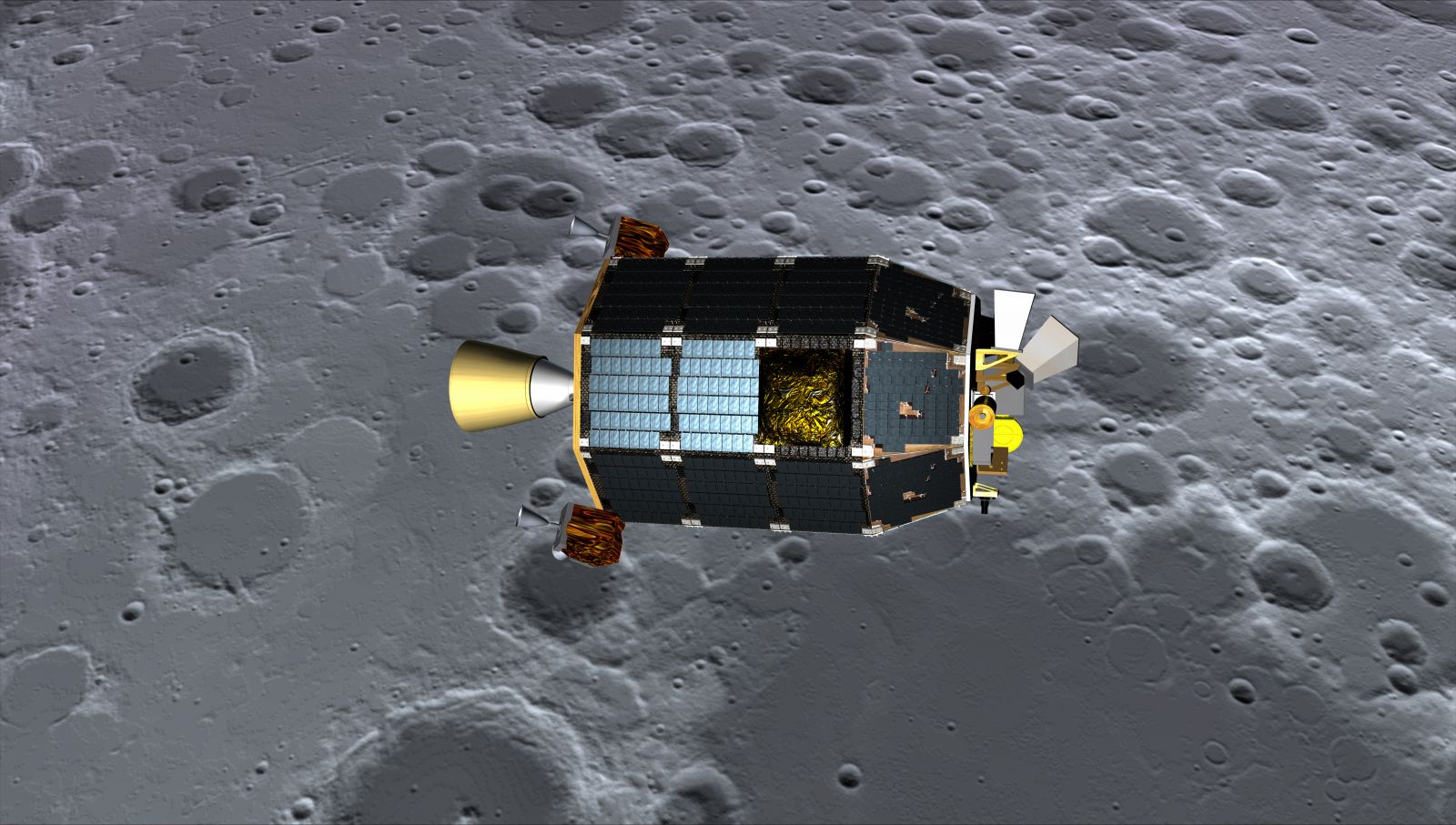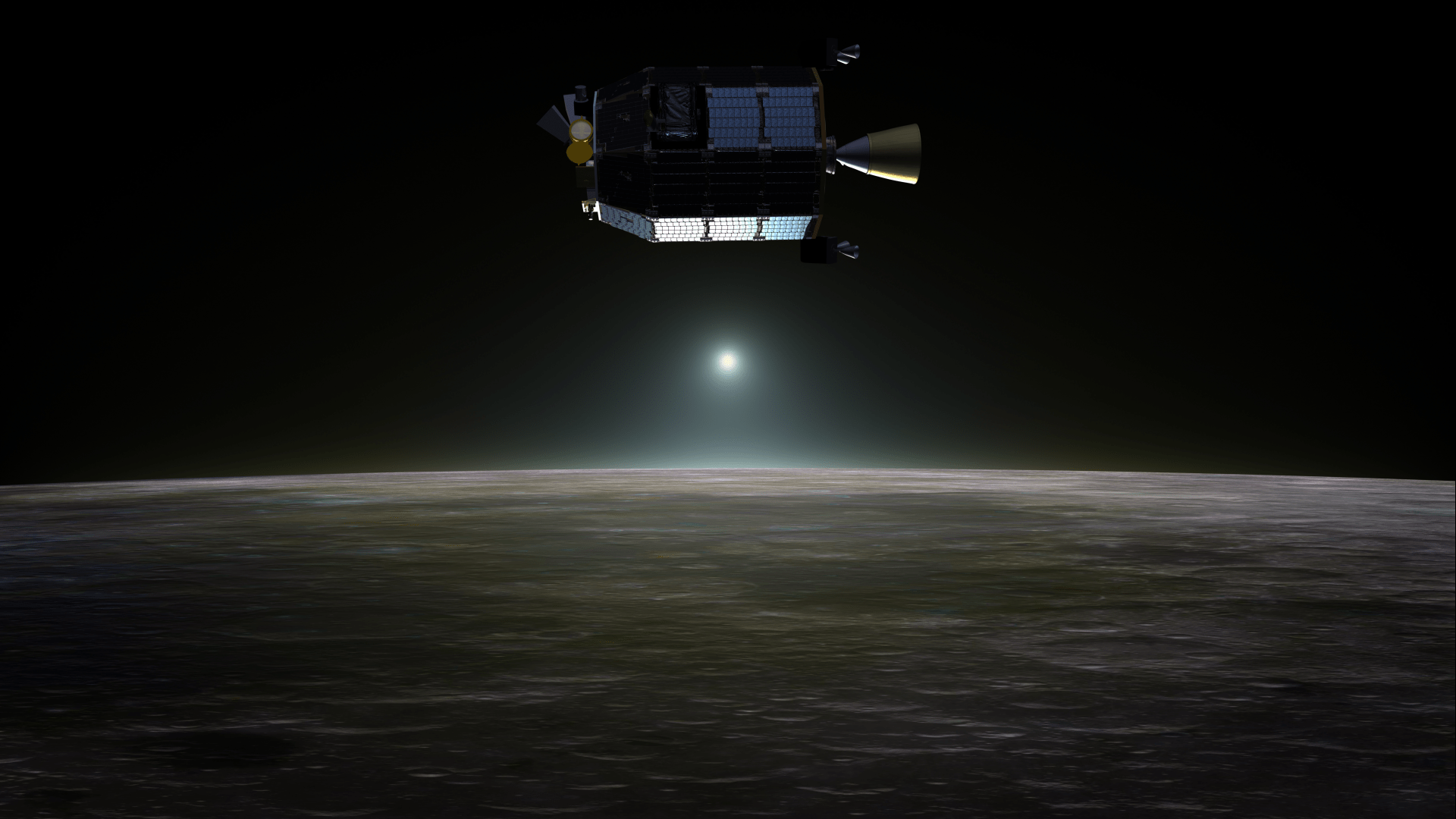The LADEE spacecraft gathered detailed information about the ultra-thin lunar atmosphere, where it comes from, how it changes and what that means for the Moon’s surface and resources.
Once the presence of significant amounts of water ice on the Moon had been confirmed by NASA’s LCROSS and LRO missions, scientists had to wonder, Where did it come from, how long has it been there, and will it last? To understand better the lunar surface and the resources it holds, researchers needed to know more about the environment the Moon exists in – that is, about the almost non-existent atmosphere that surrounds it.
Just one 25-trillionth the density of Earth’s atmosphere, the envelope of gases held to the Moon by its gravity is so thin and tenuous that it goes by another name, exosphere. Here, molecules in the air are so few and far between, they rarely come into contact with one another. Still, the gases found around the Moon do have important effects on conditions near the surface. This was the focus of NASA’s Lunar Atmosphere and Dust Environment Explorer, or LADEE.
LADEE orbited the Moon for about six months, gathering detailed information about what makes up the delicate lunar atmosphere, its structure, and how it changes. To understand the Moon’s exosphere, we also need to know about the processes controlling it. These include the effects of meteor showers, the solar wind that bombards the Moon with charged particles and exposure to the Sun’s ultraviolet radiation at the surface.
Understanding how these factors modify the exosphere also allows researchers to work backwards to a picture of its original state. Since exospheres are the most common type of atmosphere in our solar system – they surround the planets Pluto and Mercury, icy moons of the outer solar system, asteroids and more – what we learn from examining the Moon’s exosphere can be applied to these other nearly airless places, too. That will help show us how our solar system formed and is changing over time.
What We Learned from LADEE
- Origin of the Moon’s Water
The LADEE mission revealed that tiny meteoroids contribute to the Moon’s exosphere, including by delivering it water. Like bugs on a car windshield, these grains of rocky material traveling through space pelt the lunar surface almost constantly as the Moon makes its way around the Sun. On Earth, they burn up in the atmosphere as meteors, but with the almost negligible atmosphere on the Moon, the particles smash into the surface with tremendous speed. Although the grains are mostly smaller than the head of a pin, they can hit at speeds greater than 21 miles per second, releasing immense heat and vaporizing part of the soil and the meteoroids themselves. The resulting gases can then enter the lunar atmosphere.
When the number of these impacts went up – for instance, if the Moon passed through a relatively dense stream of micrometeoroids – LADEE’s instruments recorded a corresponding increase in certain gases in the exosphere. Researchers used that data to study what the fate of these additional materials might be: Would they fly off into space? Or, heated by the Sun, would they hop around the lunar surface? Based on the data, they thought that molecules like water vapor, randomly bouncing across the surface, could potentially migrate to permanently shadowed regions at the poles. There, it’s so cold that molecules slow almost to a halt and get stuck.
Researchers are still studying how the reservoir of water ice spread across the Moon’s poles got there. But, regardless of its origin, it’s an important resource that could be harvested right from the lunar surface to produce fuel, water and air for future missions.
- Moon Dust
Moon dust is so abrasive it caused a lot of wear on the Apollo spacesuits in a short amount of time. It also built up quickly in joint areas – for example, where the gloves connect to the suit – making them difficult to engage. A better understanding of material floating in the lunar atmosphere will help design the next generation of suits and equipment for the Moon’s surface.
In addition to gases, LADEE found the micrometeoroid particles striking the surface also eject lunar dust. Each particle impact sends up a spray of debris, resulting in a thin cloud of small dust particles over the area of the Moon affected.
Addressing a longstanding mystery from the Apollo era was also on LADEE’s to-do list. Astronauts in orbit around the Moon reported seeing a glow on the horizon before sunrise. One possible explanation was that lunar dust, electrically charged by the Sun’s ultraviolet light, was levitating above the surface. However, the spacecraft’s instruments found no evidence of any effect that could be seen by the human eye.
- Gases of the Lunar Exosphere
Scientists learned that the major components of the thin lunar atmosphere are helium, neon and argon. The presence of neon had been a subject of speculation since Apollo, and LADEE finally confirmed it.
To understand where the neon comes from, one of LADEE’s instruments systematically measured these gases and we now know that it is supplied by the solar wind. The solar wind is a stream of gas blowing from the surface of the Sun into space at around a million miles per hour.
The argon comes largely from the natural transformation of a radioactive form of potassium found in the rocks of all the terrestrial planets. As the Moon’s potassium decays – the term for the way radioactive material changes over time – the resulting argon percolates up to the lunar surface, where it becomes part of the tenuous atmosphere.
Like neon, the third main lunar gas, helium, comes largely from the solar wind, though may also have some contribution from radioactive decay. Scientists compared LADEE’s data to data from another NASA mission, ARTEMIS, which measured the input from the solar wind. They learned that the amount of helium in the lunar exosphere is closely tied to the amount of input from the solar wind, and that the residence time (or how long each individual atom sticks around on the Moon) for helium is just a few days. It is longer for neon and argon because they are bigger atoms, so it’s more difficult for them to escape.
The LADEE Spacecraft
These lunar discoveries were made possible by the LADEE spacecraft and its suite of three scientific instruments and one technology demonstration:
- Ultraviolet and Visible Light Spectrometer
UVS determined the composition of the lunar atmosphere by analyzing the light-based “fingerprints” of materials it found.
- Neutral Mass Spectrometer
NMS measured variations in the types of gases, their density and their distribution in the lunar atmosphere as the Moon passed through different conditions, such as exposure to the solar wind. Researchers discovered that streams of meteoroids striking the Moon infuse the thin lunar atmosphere with a short-lived water vapor. About two-thirds of that vapor escapes into space, but about one-third lands back on the surface of the Moon.
- Lunar Dust Experiment
LDEX collected and analyzed samples of lunar dust particles in the Moon’s atmosphere. It discovered an increase in exosphere dust that peaks over the area of the Moon where the most micrometeoroids are raining down. The experiment helped scientists address the mystery of whether a glow on the horizon reported by Apollo astronauts was caused by lunar dust.
- Lunar Laser Communications Demonstration
LLCD illustrated the use of lasers instead of radio waves to communicate quickly with Earth. Much like an ethernet internet connection is faster than an old dial-up modem, this laser-based system was able to send large amounts of data up to LADEE and back to Earth.
Milestones:
– Sept. 6, 2013: LADEE launches from NASA’s Wallops Flight Facility, in Wallops Island, Virginia.
– Oct. 6, 2013: The spacecraft enters lunar orbit.
– Nov. 10, 2013: LADEE’s science operations begin.
– March 1, 2014: Prime science mission ends; extended mission at lower altitude begins.
– April 17, 2014: The LADEE mission concludes with the spacecraft’s planned impact on the Moon’s surface.
Partners:
NASA’s Ames Research Center, in California’s Silicon Valley, designed, developed, built and tested the spacecraft and managed both the 100-day prime science mission and extended mission. After launch, Ames controlled the spacecraft and executed mission operations.
NASA’s Goddard Space Flight Center, in Greenbelt, Maryland, managed the science instruments and technology demonstration payload, the science operations center and provided overall mission support. NASA Wallops was responsible for launch vehicle integration, launch services and operations. NASA’s Marshall Space Flight Center, in Huntsville, Alabama, managed LADEE within the Lunar Quest Program Office.
The LADEE mission was funded by NASA’s Science Mission Directorate in Washington.
Learn more:
- Meteoroid Strikes Eject Precious Water from Moon (NASA story, April 2019)
- NASA in Silicon Valley Live – Robotic Exploration of the Moon (video episode, Oct. 2018)
- Image Archive: LADEE gallery
- NASA’s LADEE Mission Shows the Force of Meteoroid Strikes on Lunar Exosphere (NASA story, Dec. 2015)
- LADEE Project Scientist Update: August 2015
- LADEE Project Scientist Update: December 2014
For researchers:
- LADEE mission overview
- LADEE’s Science and Instruments
- The Lunar Atmosphere and Dust Environment Explorer Mission: A book about the LADEE mission by project scientist Rick Elphic, et al. (2014)
For news media:
Members of the news media interested in covering this topic should get in touch with the science representative on the NASA Ames media contacts page.



























